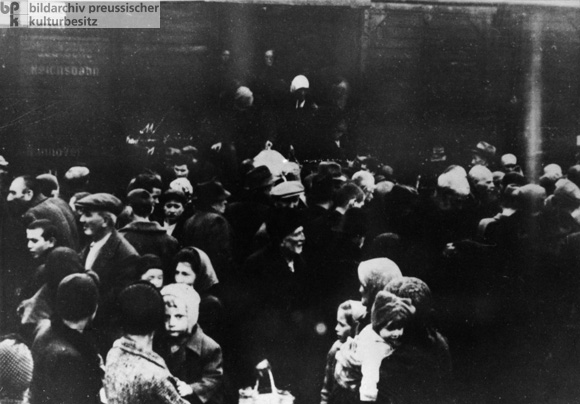













INTRODUCTION | DOCUMENTS | IMAGES | MAPS | EDITOR
|
Over the course of the 1930s, the conservative-nationalist government of Admiral Miklós Hothy (1863-1957) came under the growing influence of the Nazi regime and the position of Hungary’s approximately 700,000 Jews became increasingly precarious. In the late 1930s, the Hungarian government issued a series of anti-Jewish laws that denied Jews civil rights and severely restricted their economic and professional opportunities. After Hungary joined the war on the side of the Axis in November 1940, Jewish men of military age were drafted into mobile labor battalions and forced to work on war-related projects under perilous conditions. This program claimed at least 27,000 Jewish lives. Moreover, in the summer of 1941, approximately 20,000 Hungarian Jews were deported to German-occupied Ukraine and shot by members of the so-called Special Operation Units [Einsatzgruppen], mobile killing squads tasked with “cleansing” the newly occupied territories of Jews. Still, for a time, most of Hungary's Jews believed themselves safe from the Nazi annihilation machine. But after the Germans occupied Hungary on March 19, 1944, it became clear that they had been mistaken. The newly installed collaborationist regime demanded that the country's Jews be rounded up and handed over. In mid-May 1944, the Hungarian authorities, working in close collaboration with Adolf Eichmann and the German Security Police [Sicherheitspolizei] began systematic deportations. Over the next two months, approximately 440,000 Hungarian Jews were deported. Most were sent to Auschwitz, where the majority were killed shortly after their arrival.
This photograph shows the arrival of a transport of Hungarian Jews from Subcarpathian Rus, which became part of Hungary after the signing of the Munich Agreement. The selection process, whereby new arrivals were designated as either "fit" or "unfit" for forced labor, began as soon as they stepped onto the train platform. Those deemed "unfit" were brought to the gas chambers. The photograph comes from the "Auschwitz Album," a collection of 193 photographs documenting the arrival and selection of one or more transports of Hungarian Jews in May/June 1944. The photographs were taken by SS Hauptscharführer Bernhardt Walter and his assistant, Unterscharführer Ernst Hofmann. (The two worked as photographers for the camp’s Identification Service [Erkennungsdienst] and were responsible for photographing and fingerprinting the prisoners who were selected for work.) Members of the SS put Walter and Hofmann's photos of the Hungarian Jews into an album that bore the innocuous sounding title "Resettlement of the Jews of Hungary."
Eighteen-year-old Lili Jacob (1926-1999) and her family were among those Hungarian Jews from Subcarpathian Rus who were deported to Auschwitz. From there, Jacob was sent to the Dora-Mittelbau camp, where she worked as a forced laborer until her liberation in April 1945. It was there that she found the album in an abandoned SS barracks. She recognized herself and various family members (e.g., two of her brothers and her grandparents) in certain photographs. She was eventually called as a witness in the First Frankfurt Auschwitz Trial (1963-65), where she presented the album to the court. In 1980, Lili Jacob donated the "Auschwitz Album" to Yad Vashem.
© Bildarchiv Preußischer Kulturbesitz / Bernhardt Walter, Ernst Hofmann Jerusalem, Yad Vashem Historical and Art Museum |
 print version
print version return to image list
return to image list previous image
previous image
